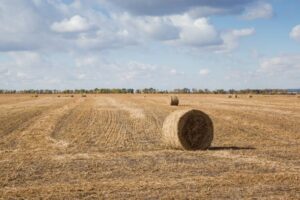Silage wrap is an effective way to preserve bales of hay and straw. It also keeps bales safe from UV damage, making them more attractive and more valuable when used for animal feed. One of the benefits of it is the principle of silage wrap recycling, where used wraps can be reused.
Bales should be wrapped immediately after baling to limit oxygen movement and prevent fermentation. It can be done with either tube wrapping or single-bale wrap.
Durability
Silage wrap is typically made from quality LLDPE with UV stabilizers to prevent mould and shock. Unlike net wrap, it’s thicker and more substantial, providing greater strength when wrapping bales.
 As you know, a key goal is to lock out oxygen to preserve the freshness of your baleage and ensure premium silage for animal feed. When oxygen gets in, it starts to break down plant sugars into CO2, creating heat that causes damage to the hay or straw and decreases the overall nutritional value of your forage.
As you know, a key goal is to lock out oxygen to preserve the freshness of your baleage and ensure premium silage for animal feed. When oxygen gets in, it starts to break down plant sugars into CO2, creating heat that causes damage to the hay or straw and decreases the overall nutritional value of your forage.
To avoid this, you should keep a close eye on your bales to make sure they’re well-wrapped. Bales that are wrapped too loosely can allow oxygen to leak in, causing spoilage and reduced feed value. The ideal moisture level for hay or straw baleage is 45-55%. Moisture levels lower than this can trigger clostridial fermentation, with high levels of butyric acid and ammonia.
Ease of Use
When you use the right silage wrap for hay baling, you can expect it to protect the nutrients in your ensiled product. Look for plastic that offers outstanding cling and puncture resistance for the most reliable results. It should also be treated to resist UV rays and be resistant to mildew.
Bales wrapped with the right amount of plastic will stay fresh longer, and they can even be stored in a non-climate-controlled area and qualify for silage wrap recycling. It can be especially beneficial for grass or legume crops, where the nutrient content of the feed may decline over time.
Some farmers prefer to wrap hay bales with a moisture level of 45%-55% to help promote optimal fermentation and resulting nutritional value. Moisture levels lower than this can lead to little to no fermentation, while higher moisture content can result in clostridial fermentation and high production of butyric acid and other damaging substances.
Wrapping a large round bale of hay will require some manual effort. However, a quality all-in-one combination baler can help make the process easier. These machines compress the bale tightly and apply consistent pressure as they roll it in the tube, making it a much more compact and solid package that is easier to wrap.
Security
While some farmers use net wrap to cover round bales, the material often sheds water and does not allow air to escape. It can lead to moisture condensation and spoilage. A breathable film like Tama’s B-Wrap allows hay to breathe, even after being wrapped. It also prevents the accumulation of oxygen that can cause fermentation and decomposition.
Another option for wrapping bales is silage wrap, which comes in a range of thicknesses and materials. Producers can choose between monolayer or multilayer films, which differ in attributes, including UV stabilizers and puncture resistance. Most hay and straw producers recommend using a minimum of 6 mils of plastic (four layers of 1.5-mil film) to limit available oxygen in the bale.
Unlike net wrap, which can break easily, a silage wrap can protect hay and straw from mould and absorb shocks during transport, aside from being eligible for silage wrap recycling. It can also help maintain the shape of the bale and reduce moisture content, which can result in a more consistent crop with better yields.
Choosing the right wrap for a specific operation requires some research. A few factors to consider include how often the bales are handled, where they will be stored and whether they will be kept indoors or outdoors. When storing a baled forage outside, the bales should be wrapped as soon as possible to minimize oxidation and damage from rain or wind.
Visibility
Silage wrap is available in a variety of colours to help ensure that your bales are visible at all times. It can help with reducing accidents that may occur when handling bales, as well as preventing waste and theft.
The best silage films feature UV protection, elasticity and tact (stickiness), puncture resistance, and a high degree of film transparency for improved visibility. Additionally, they are designed to be long-lasting and durable, avoiding tearing or breaking down quickly over time.
